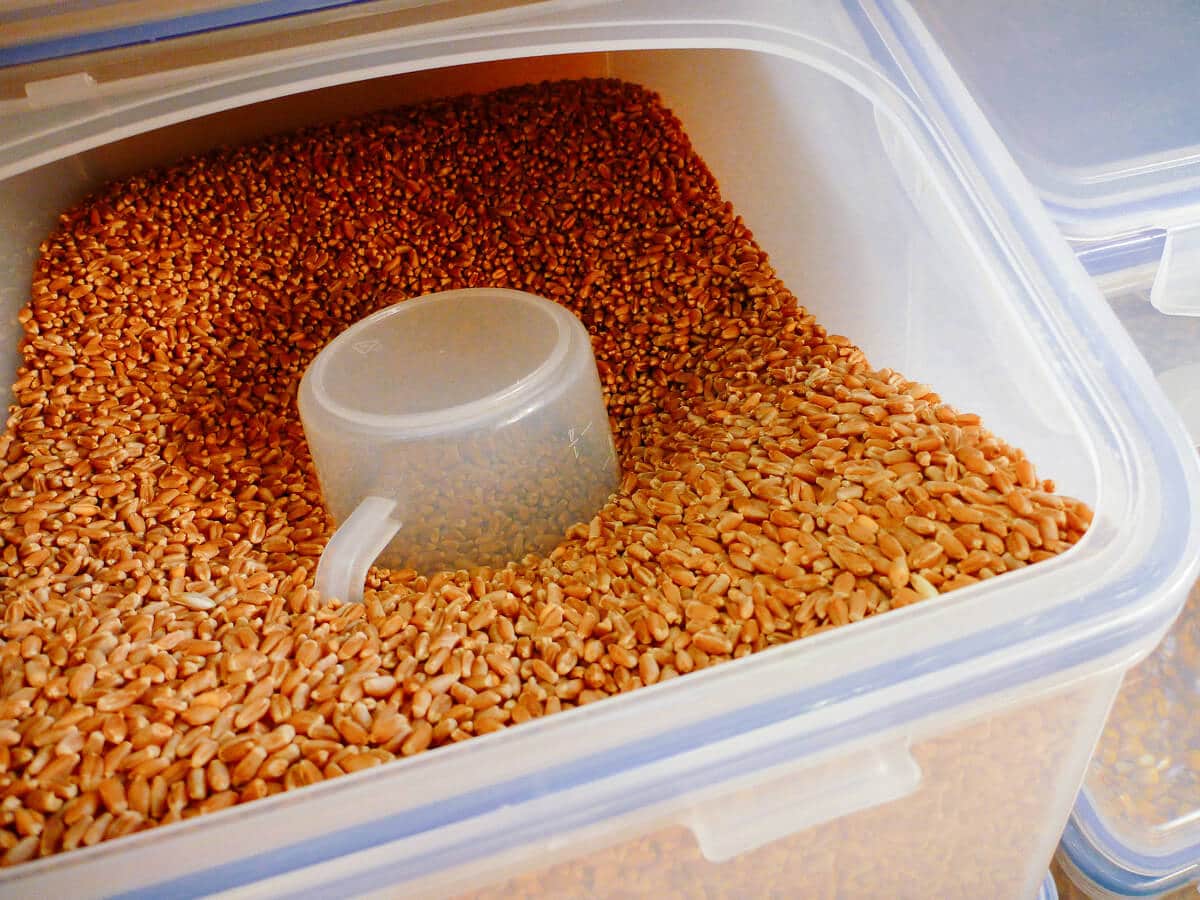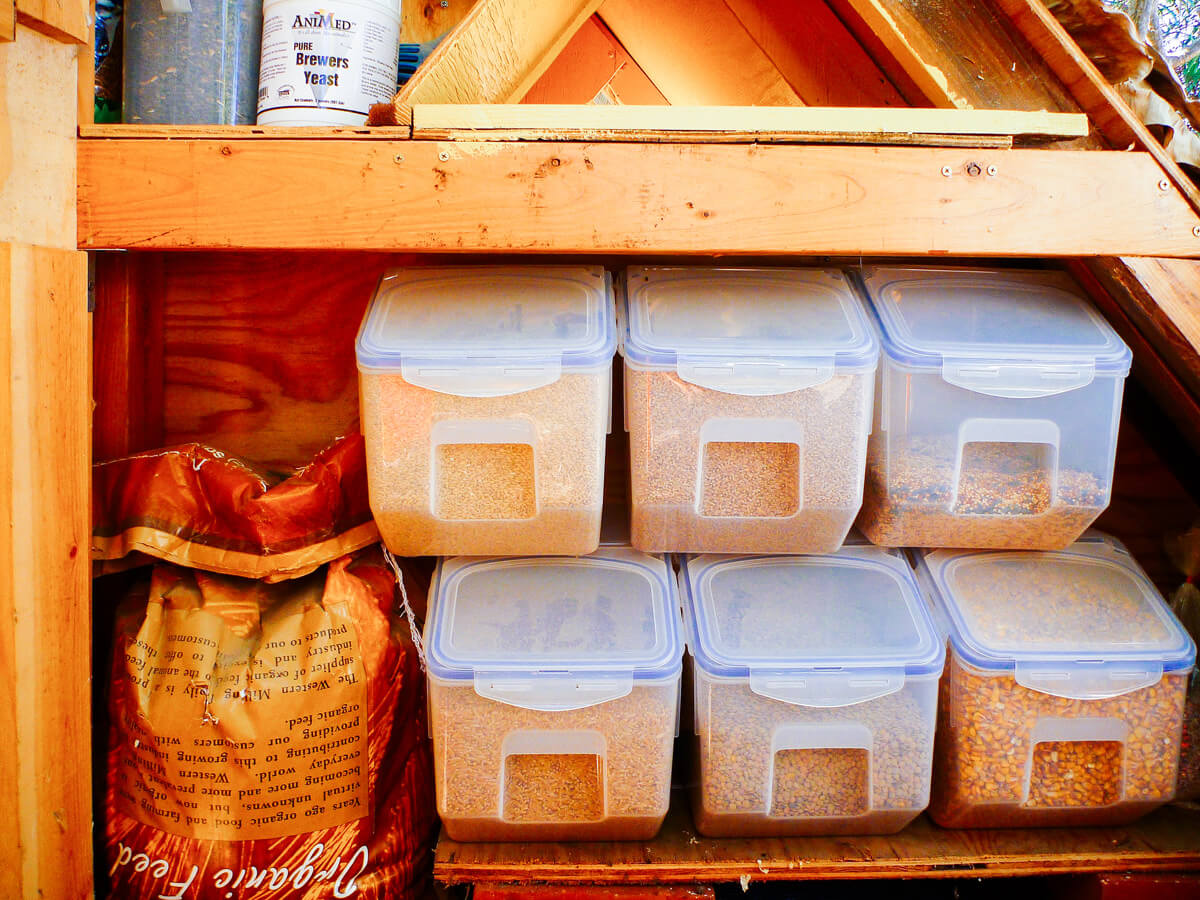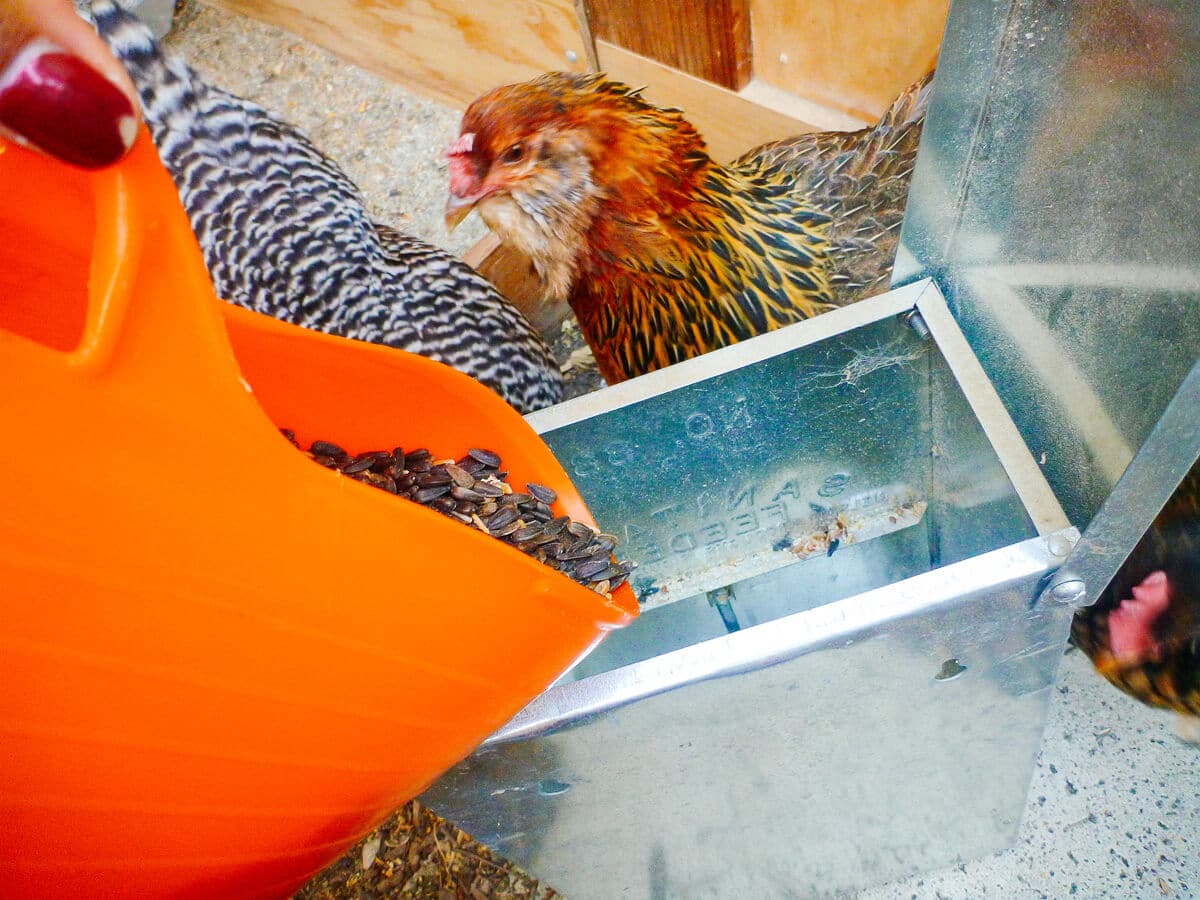Update: I also have a soy-free corn-free version of my homemade whole grain chicken feed! For easy formulating, download Garden Betty’s Chicken Feed Calculator to manage costs, calculate protein content, and custom mix your feed on the fly.
More than nine years ago, I started mixing my own soy-free, mostly organic, whole grain chicken feed, and it’s still the best feed I could possibly give my hens. (I’ve tried the entire lineup from the feed store.)
The decision to feed a whole grain diet—versus a commercially formulated diet—is a personal one based on what I believe is best for my hens. Luckily, it also turned out to be an economical decision and a benefit to my own diet.
Homemade chicken feed is not as expensive or complicated as you may have thought or been told.
My small flock of hens lays two dozen eggs a week on a DIY diet of whole grains and leafy greens. Their feathers are soft and shiny, their personalities as perky as ever… so I must be doing something right!
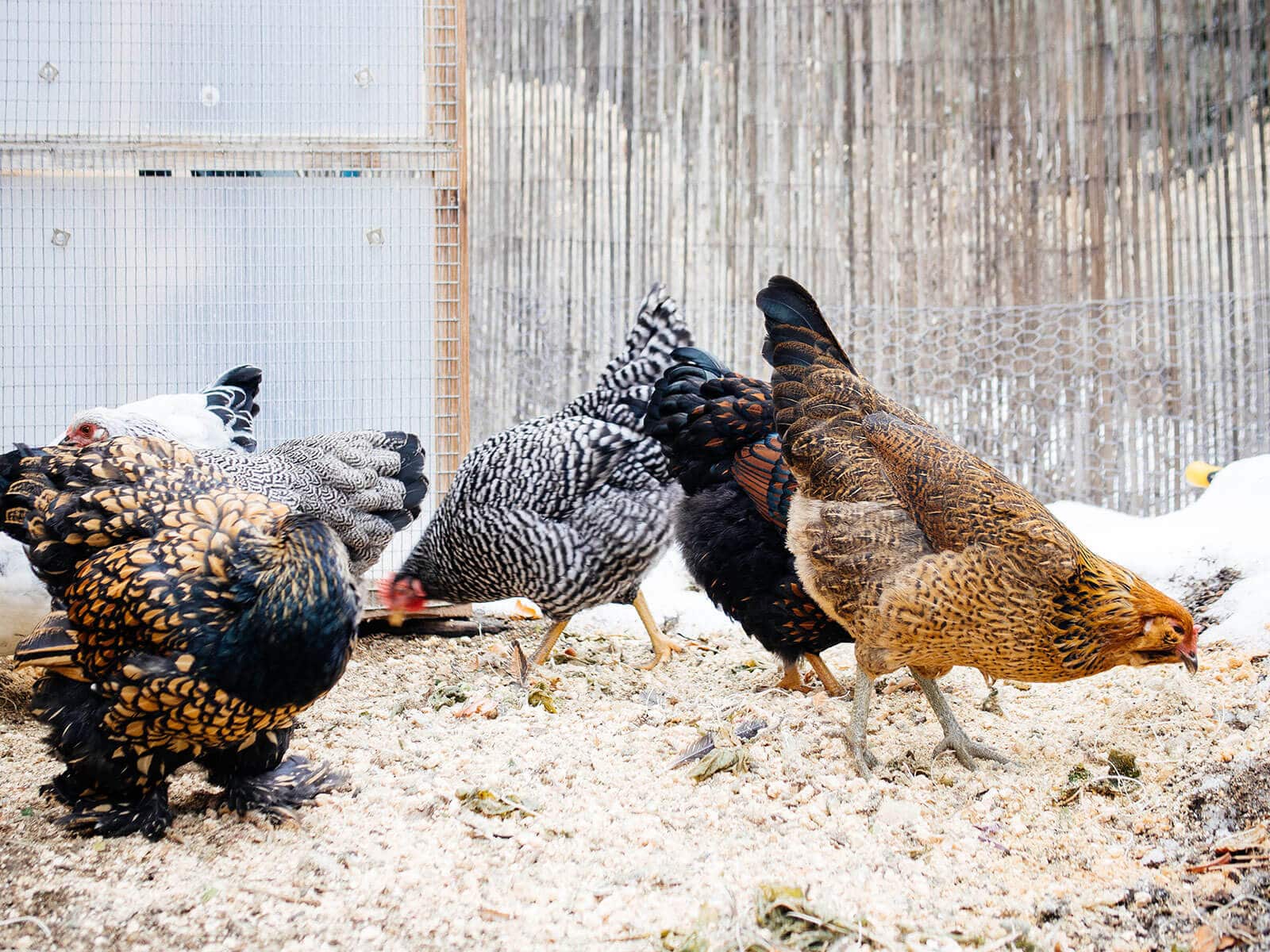
Why should you make your own whole grain chicken feed?
Commercial poultry feed comes in crumble or pellet form, neither of which looks like real food to me. Since real food comes out of my chickens, I want real food to go into them.
Crumbles and pellets are already formulated to contain the nutritional balance that a chicken needs, but the process of cracking, mashing, pressing and/or heating the grains (often times, not even quality grains) causes them to go stale and lose some of their nutritional value—even months before you buy them.
On the other hand, whole grains (which you can pick and choose) retain all of their nutrients.
With a whole grain diet, I’ve noticed that my hens eat less and poop less (as opposed to the crumble diet they started on). This leads me to believe that their bodies are processing the food better and it’s not just passing through them.
Disclosure: Garden Betty earns commissions on purchases made through these links to my affiliated retailers. View my policy.
Is a homemade whole grain diet a complete diet for a chicken?
Like humans, chickens need a diverse diet and sometimes they need a different diet in winter than they do in summer.
The greater variety of grains, legumes, and seeds you can provide your chickens, the healthier and happier they will be.
Layers need at least 16 percent protein and the rest is common sense—not too much fat, not too many carbs, and that last piece of chocolate cake is probably not a good idea. It’s all about balance.
I imagine that people wanting to make their own feed at home are likely also the sort of chicken keepers that let their chickens forage for bugs and weeds, or give their chickens mealworm treats and kitchen scraps. So overall, yes—this is a complete diet.
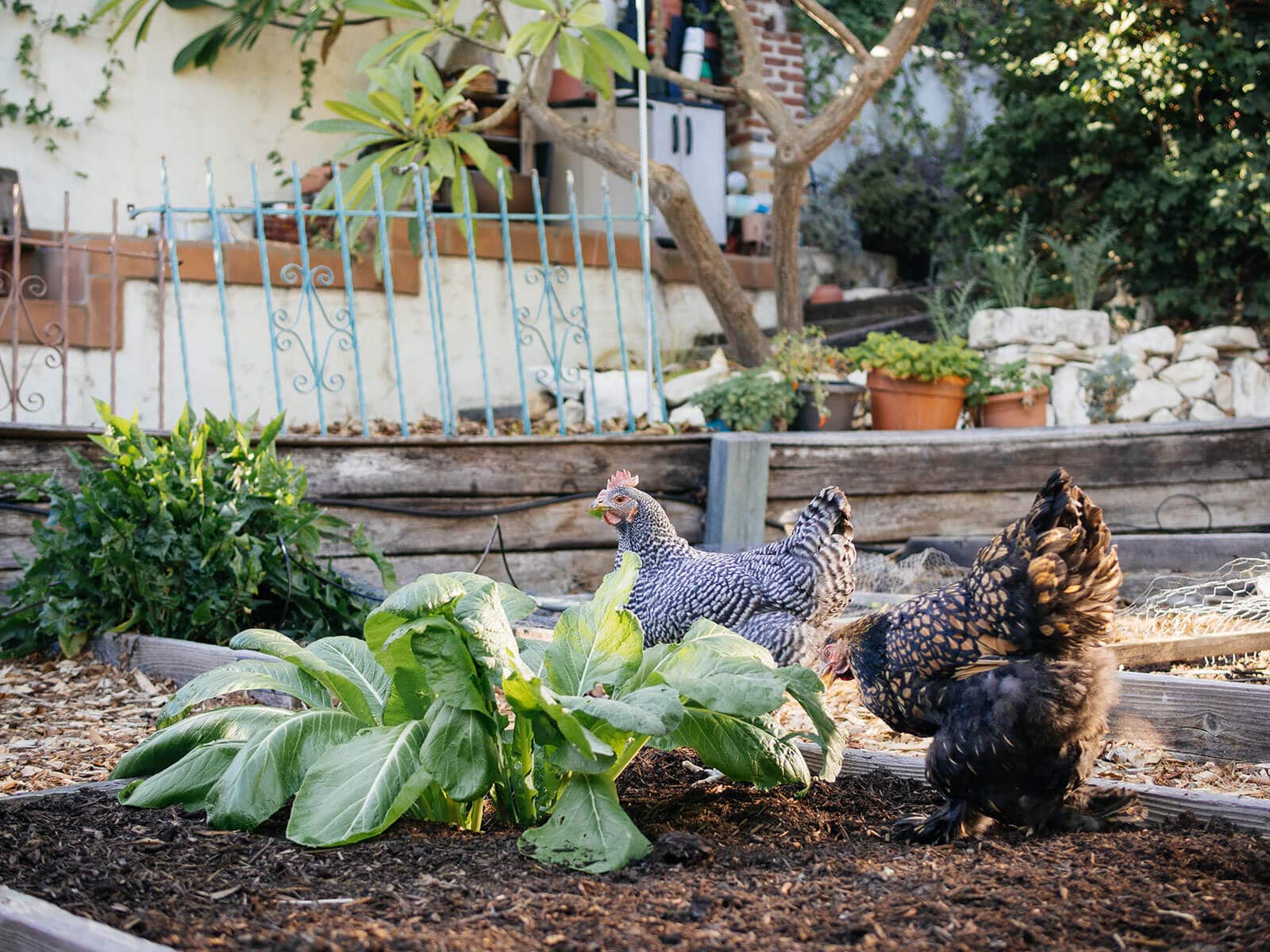
Why should chicken feed be soy-free and organic?
Because of its cheapness, availability, and high amount of protein, soy is a large part of a commercial chicken’s diet. But it’s also an incomplete protein, an unnatural source of food, and a highly processed food.
As with anything highly processed, soy has potentially harmful health effects ranging from vitamin deficiencies to hormone disruptions—especially when consumed in the crazy amounts that our culture does.
Soy is one of the most genetically-modified foods in the world, and it’s included in almost everything we eat. I know I can’t avoid it in my diet, but I can limit my intake of soy by choosing not to feed it to my chickens. You are what you eat.
(A pro-soy study found that soy protein transferred to the egg yolks and tissues of commercial chickens—even commercial “organic” chickens—fed a predominantly soy diet.)
An all-organic feed was originally not as important to me as a soy-free feed. I felt the benefits of a whole grain diet outweighed those of an organic (but processed) diet.
As it turned out, my homemade poultry feed is almost all organic, thanks to bulk purchases from Azure Standard and my local supermarket.
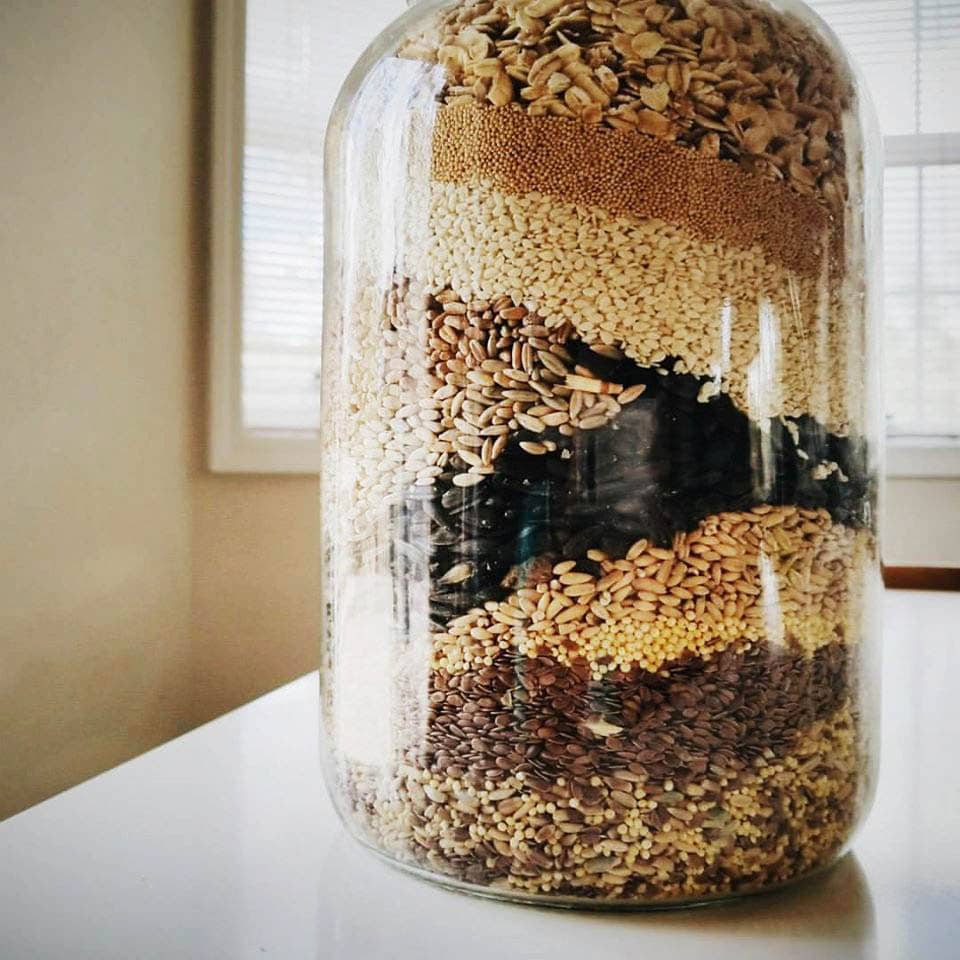
How much does DIY chicken feed cost?
My homemade chicken feed actually costs the same as the commercial poultry feed at my local feed store. This may not be true for everyone, but on the west coast, a premium bag of soy-free, organic layer pellets averages $0.70 per pound.
My soy-free, almost organic, whole grain feed costs $0.69 per pound (and would even be less if I purchased in larger bulk quantities—but I have a small flock and very limited storage).
This isn’t cheap chicken feed by any means, but it’s also not exorbitantly expensive considering the quality ingredients that go into it. You can lower the cost by going in with a fellow chicken-keeper on 50-pound bags of grains, or by using animal-grade ingredients instead of human-grade (which is what you’ll find in feed stores, and they’re perfectly acceptable).
An unexpected advantage of mixing my own feed is that I can share a lot of the grains, legumes, and seeds with my chickens, and I even use some of the same grains in my homemade dog food.
The ingredients are all human grade and mostly organic, and the fact that they can feed the whole household makes buying 10- or 25-pound bags of grains more feasible.
While there was a lot of legwork in the beginning to make my own recipe, the payoff is learning more about nutrition than I ever thought I would and knowing what goes into my chickens’ food (and ultimately, what goes into me).
I mix a new batch of feed two or three times a month. It feels like garden therapy. I have a strange love for running my hands through a mountain of whole grains.
It’s not any more work than refilling the feeder with bagged feed, and I have the option of changing up the mix every once in a while, rather than being stuck with the same 50-pound bag of commercial feed.
(This is advantageous if you have a mixed flock of chicks, pullets, and/or layers with varying protein needs, or want to alter their diet in winter or summer. I cover the nutritional needs of different age groups in my post that helps you calculate protein for your own chicken feed.)
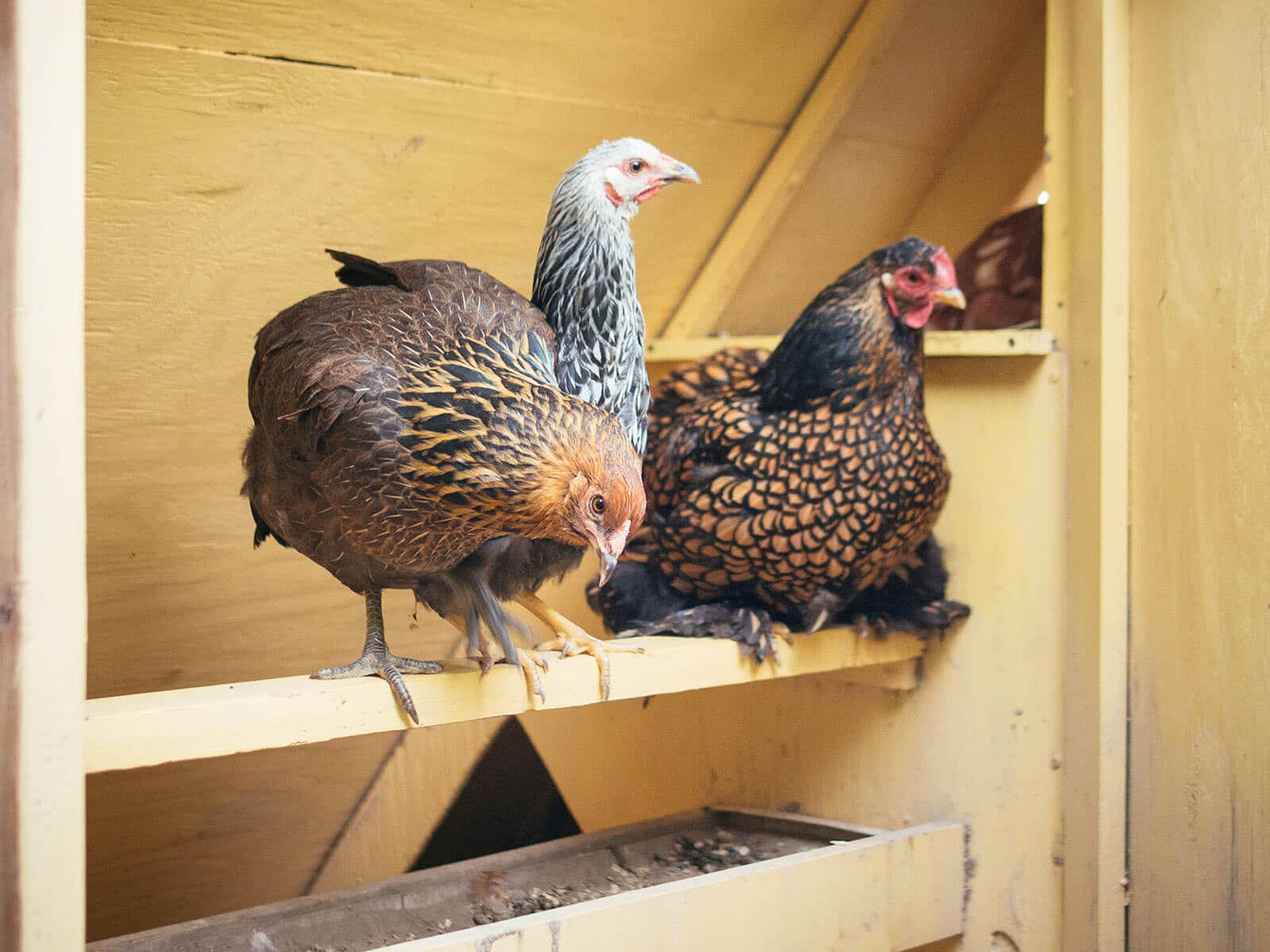
How do you find all the ingredients for homemade chicken feed?
Most of my grains are purchased from Azure Standard. As a natural food co-op that delivers nationwide, Azure Standard carries bulk bags of hard-to-find items like kamut and kelp, and sometimes at a better price than Amazon.
The rest of my ingredients come from local stores with a wide variety of bulk grains. (WinCo Foods was my go-to in Southern California, and still my favorite for cost, selection, and convenience. Market of Choice is my current stop in Central Oregon when I need a last-minute refill or want to try something new.)
You can find more exotic grains at places like Whole Foods Market, Sprouts Farmers Market, and in countless other natural food grocers and bulk food markets.
Your local feed store or grain mill will also carry the basics like oats, wheat, millet, and corn.
Oyster shells and grit are common ingredients found at any feed store or farm/livestock/poultry supplier.
How do you store all the whole grain ingredients?
Whole grains store for a very long time in cool and dark locations. Unless you go through a lot of feed quickly, I wouldn’t suggest keeping the grains in their original bags once opened, because weevils and rodents will think they’ve scored a buffet.
If you have a lot of space or a lot of chickens, you can dump all your ingredients into a clean metal trash can with a lid or a large galvanized steel bucket with a lid, mix them all up, and scoop out from there.
If you lack adequate space or keep a small flock, like I do, you can store the ingredients in airtight bins and mix as you go.
I scoop everything into a flexible bucket, give it a good mix, and pour the fresh food into the feeder. It’s like Christmas Day for the chickens… multiple times a month!
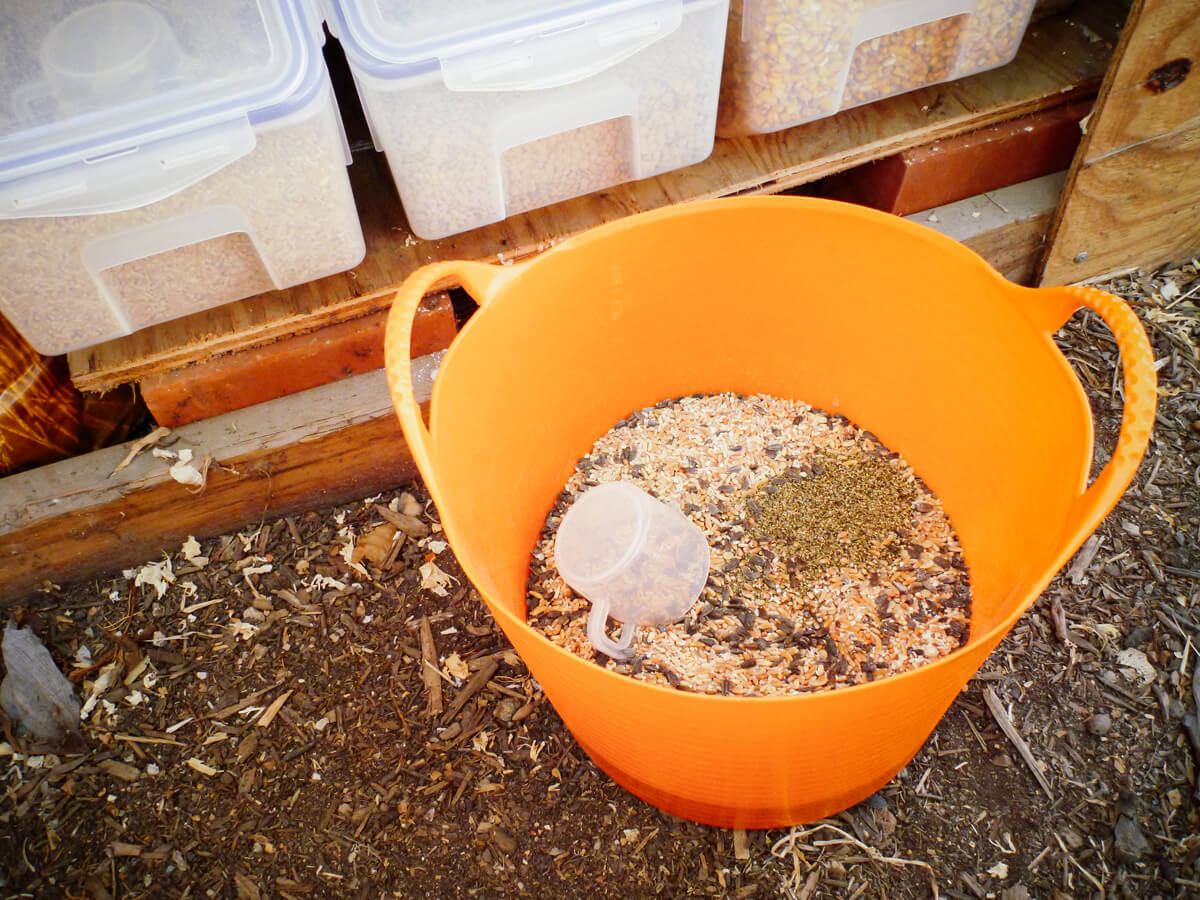
Update: Since this post was originally written, I’ve moved on to a new chicken coop that doesn’t have on-site storage, so I keep all of my grains and seeds in the garage. I’ve also added a few other containers — that I like just as much, if not more than my first containers — which are all linked in my sources at the end of this post.
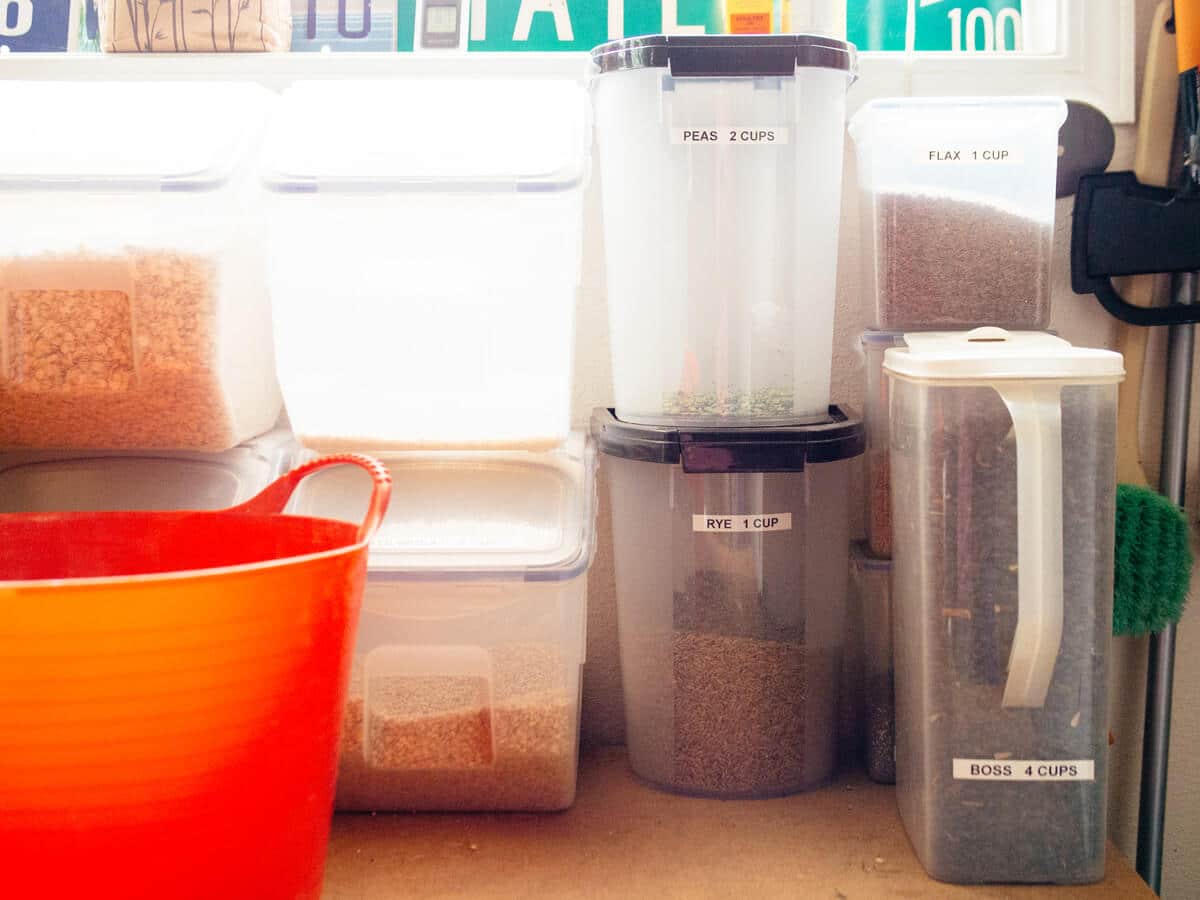
How do you switch a flock from crumbles/pellets to whole grains?
Start by gradually mixing in a little bit of whole grains into your chickens’ current feed to adapt their gizzards.
If they don’t forage frequently, make sure you offer them grit in a separate, free-choice feeder (I use this one).
Chickens don’t have teeth, so they swallow a small amount of grit and store them in their gizzards to grind up food. This is especially important for whole grains that need to be broken down.
Increase the amount of whole grains in their feed each week, until eventually you’re only feeding them whole grains. It may take a few weeks for your chickens to adjust to the change, so don’t be alarmed if egg production drops off a bit.
They may also start flinging grains all over the place (you’ll soon learn what they like and don’t like) or picking out certain grains first. (I believe chickens know what their bodies need nutritionally, so some days they may feed on more protein, less calcium, etc.)
Because of this, it’s a good idea to start with small amounts of different grains and seeds, and see what your chickens will eat before buying in bulk.
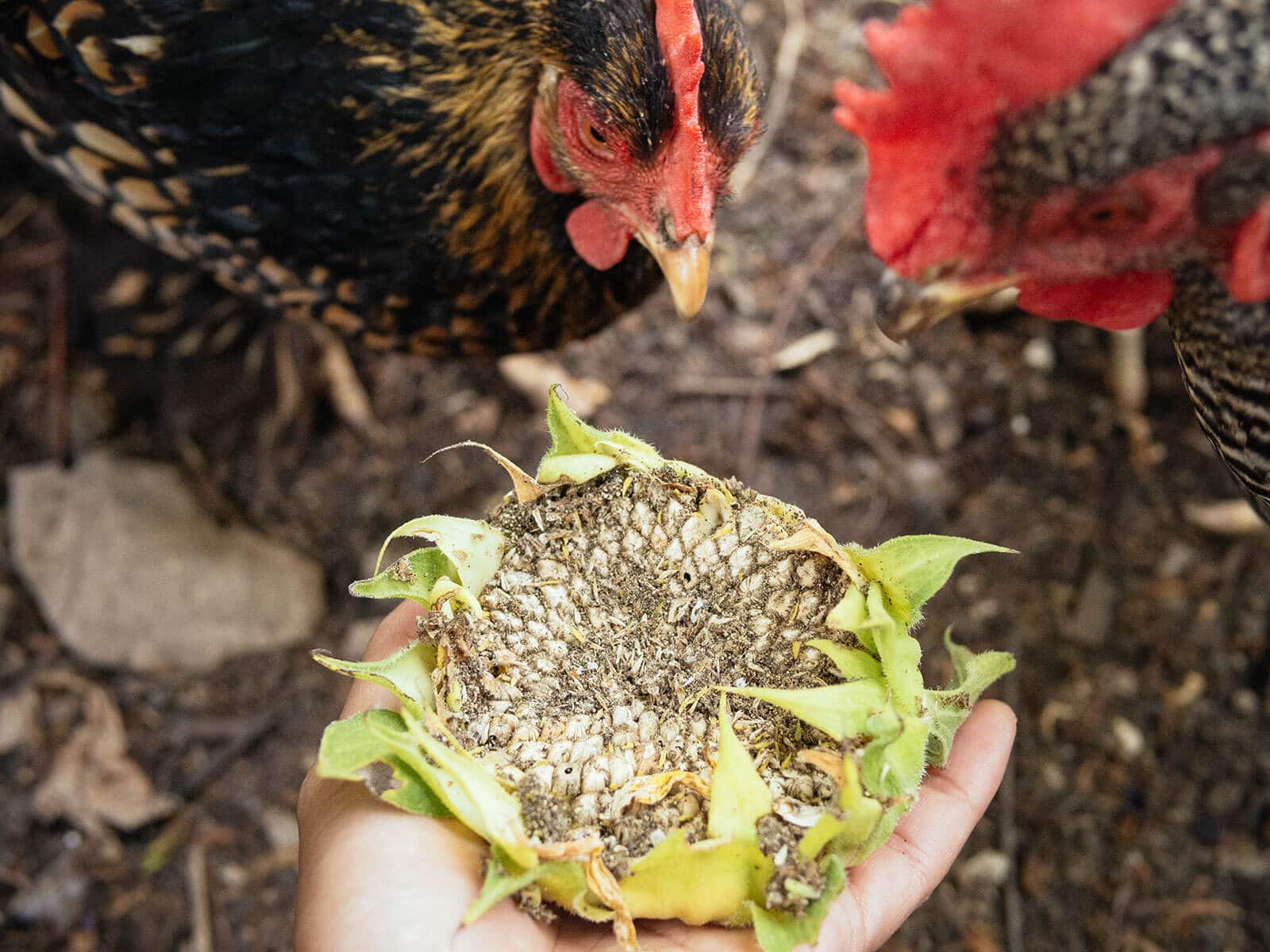
How much protein do chickens need?
My homemade chicken feed is around 17 percent protein, which is in the target range for laying hens.
This is a good number to know if you’re only feeding whole grains. But if you supplement their diet with pasture, scratch, mealworms, and kitchen scraps, all that food will increase (or decrease) the amount of protein they take in each day, so don’t get too hung up on the number.
The cool thing about making your own feed is being able to custom make it for your flock. You can make this chicken feed in bulk if you have a larger flock, just scale the recipe accordingly.
Keep reading for lots of suggestions and alternatives so you can create the best homemade chicken feed for your flock!
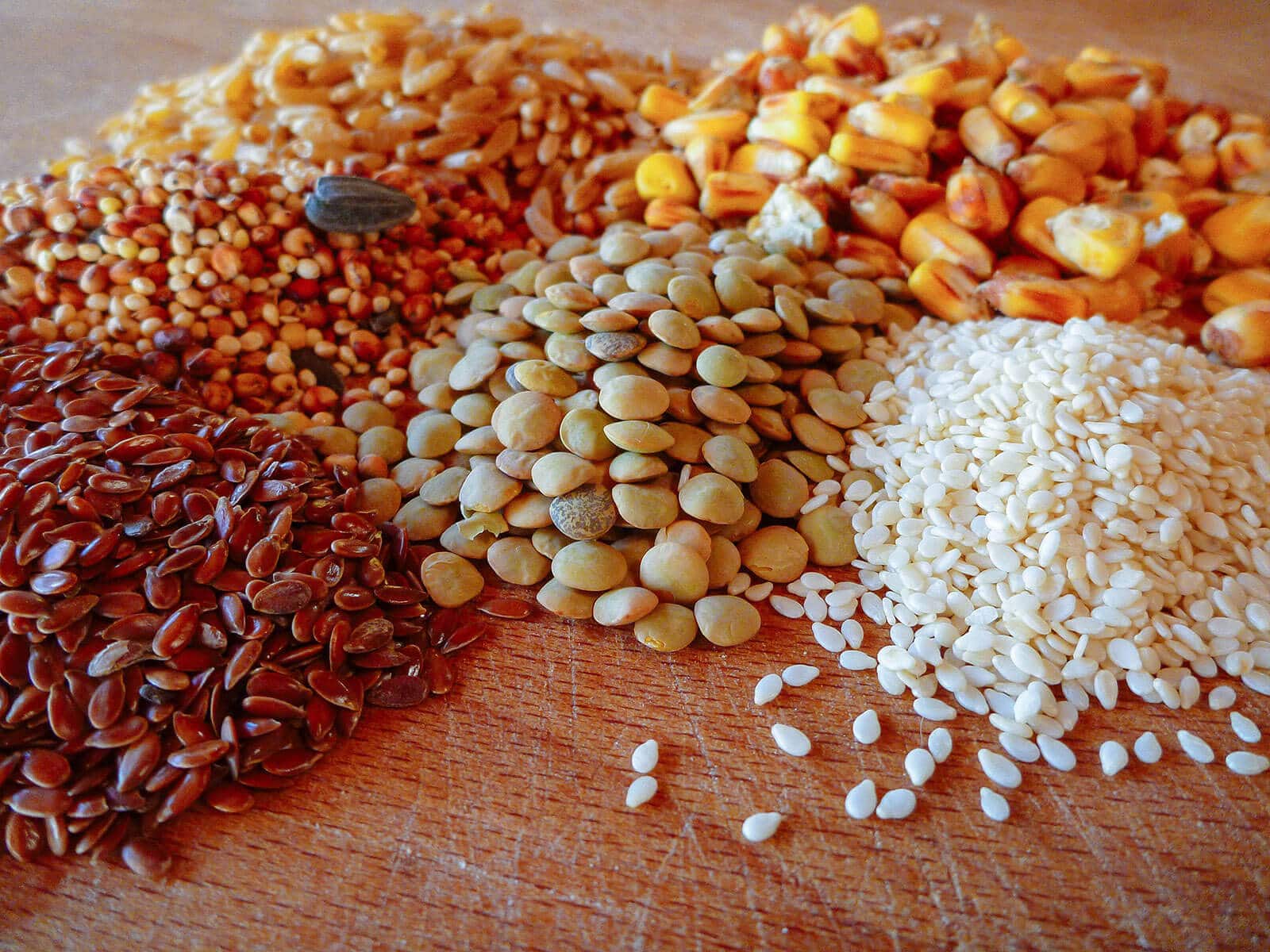
Garden Betty’s Homemade Whole Grain Chicken Feed
Makes 8 1/2 pounds (fills 10-pound feeder)
Ingredients
4 cups oat groats
4 cups black oil sunflower seeds
4 cups hard red wheat berries
2 cups soft white wheat berries
2 cups kamut
2 cups millet
2 cups whole corn
1 cup lentils
1 cup sesame seeds
1 cup flax seeds
1/2 cup brewer’s yeast
1/4 cup kelp granules
Free-choice oyster shells
Free-choice grit
Oats are rich in protein (around 16 percent), B vitamins, calcium and fiber. Oats are also a good (and cheap) source of energy. All oats—no matter how they’re processed—are nutritionally similar, so you can feed oat groats, steel-cut oats, rolled oats, and quick oats interchangeably.
Black oil sunflower seeds (often called BOSS) are like candy to chickens. But good candy! BOSS is high in protein (averaging 17 percent), rich in minerals and vitamins, and the high oil content gives feathers a beautiful gloss. BOSS is typically found in the bird seed aisle at pet and feed stores, and I buy mine from a local farm and garden store. You can also substitute striped sunflower seeds (the seeds that are typically packaged as human snacks), but they tend to be larger than BOSS with thicker shells.
Wheat is a major energy source for chickens. If you can find both varieties, buy hard red wheat and soft white wheat for the best nutritional balance. Otherwise, feed only hard red wheat, as it contains more protein (around 15 percent).
Kamut is actually a brand of khorasan wheat, but these days the grain is simply known as kamut… the way kleenex is synonymous with tissue. It’s an ancient Egyptian grain that’s nutritionally superior to other wheat in terms of protein (18 percent), magnesium, zinc, and vitamin E.
Millet (unhulled) is found in most bird seed, and in fact, the millet I buy is a mix of red and white millet sold at the store as “wild bird food.” It’s less expensive than human-grade hulled millet, but still rich in amino acids and iron. Feed stores sometimes label the unhulled white millet as “proso millet” (not to be confused with spray millet, which is a long and thin seed head).
Whole corn is a fairly large kernel, so depending on your chickens, you may have to crack or grind the corn first. You can also feed popcorn kernels, which are half the size and easier for smaller breeds to pick up. Corn is low in protein, vitamins, and minerals, but it does provide energy and fat (which is especially helpful in winter).
Lentils are very high in protein (at least 26 percent) and if your chickens take to them, it’s worth adding more to your feed. Mine don’t particularly care for lentils or any legumes, for that matter, so I only add a small portion to my feed.
Sesame seeds have one of the highest amounts of protein in a seed (around 25 percent), so they’re especially good for picky chickens that won’t eat legumes. They’re also one of the more expensive ingredients in my feed, so I add them sparingly.
Flax seeds boost omega-3 fatty acids in eggs, and are also rich in protein (37 percent), B vitamins, and minerals.
Brewer’s yeast (animal grade) can be found online or at local feed stores. You can buy human-grade brewer’s yeast too, but you’ll end up paying double (at least). It’s an important source of B vitamins and protein (around 35 percent) for chickens. (On a side note, I’ve also read that feeding brewer’s yeast to your dog will repel ticks and fleas, in addition to providing all the other good stuff.)
Kelp granules (or kelp meal) are basically little bits of dried seaweed. Kelp contains essential vitamins, minerals, amino acids, and salt that your chickens need. It promotes healthy growth, increases egg production, and darkens yolk color—an overall superior supplement.
Oyster shells provide the necessary calcium to strengthen your chickens’ eggshells. Feed this free choice, and they’ll take what they need each day. You can also feed them clean, crushed eggshells to put all that calcium back into their bodies.
Grit is typically limestone or granite gravel that aids the gizzard in grinding food. If your chickens free range, they’ll probably pick up little stones on their own and won’t take as much from the free-choice grit.
Other good sources of protein include triticale, field peas, and split peas (or any peas in general — many soy-free commercial feeds rely on peas to provide sufficient protein).
If money is no object, you could also add quinoa, spelt, wild rice, amaranth seeds, nyjer seeds, hemp seeds, or shelled peanuts as excellent protein sources.
Feeding lower-protein grains like rye, barley, buckwheat, and sorghum (milo) in small amounts will balance the higher-protein (and usually higher-cost) grains.
Try not to make your feed too heavy on any particular grain. The University of Kentucky College of Agriculture offers good information on the pros and cons of common feed grains on their Poultry Extension site.
At the end of the day, if you feed a balanced meal of grains, greens and garden pests—with a little treat here and there—numbers are not as important as a diverse diet.
Where to buy chicken feed supplies
[show_shopthepost_widget id=”3116483″]
Lock & Lock Bulk Storage Bin | Lock & Lock Square Tall Food Storage Container | Buddeez Plastic Storage Container for Pet Food | Iris Nesting Airtight Pet Food Container | Tubtrugs Storage Bucket | Miller Baby Fig Feeder | Little Giant Galvanized Hanging Feeder | AniMed Pure Brewers Yeast | Starwest Botanicals Organic Kelp Granules | Scratch and Peck Feeds Oyster Shell | Scratch and Peck Feeds Grower Grit
Homemade Corn-Free Soy-Free Chicken Feed With Whole Grains
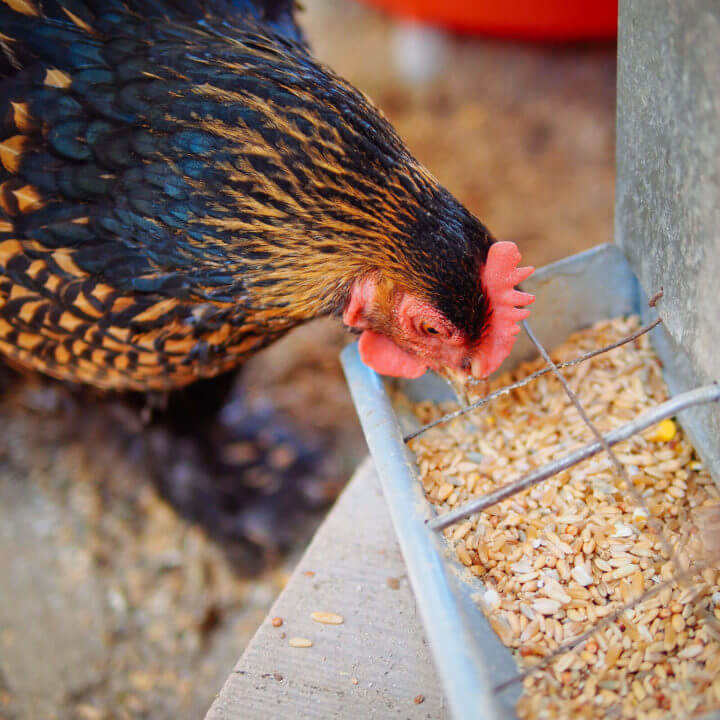
Garden Betty's homemade whole grain chicken feed just got better. This new recipe is corn-free (as well as soy-free) and makes the perfect feed for your favorite layers.
Ingredients
- 4 cups oat groats
- 4 cups black oil sunflower seeds
- 4 cups hard red wheat berries
- 2 cups soft white wheat berries
- 2 cups triticale berries
- 2 cups rye berries
- 2 cups millet
- 2 cups sesame seeds
- 1 cup flax seeds
- 1/2 cup brewer’s yeast
- 1/4 cup kelp granules
- Free-choice oyster shells (or crushed eggshells)
- Free-choice grit
Instructions
- Combine all of the ingredients, except the oyster shells and grit, in a small bucket.
- Fill your feeder with the mixed-grain feed, or store the feed in a pet food container or a galvanized steel bucket with a lid.
- Offer the oyster shells and grit in separate small feeders for your chickens to eat as they wish.
This post updated from an article that originally appeared on June 29, 2012.
View the Web Story on homemade whole-grain chicken feed recipe.



